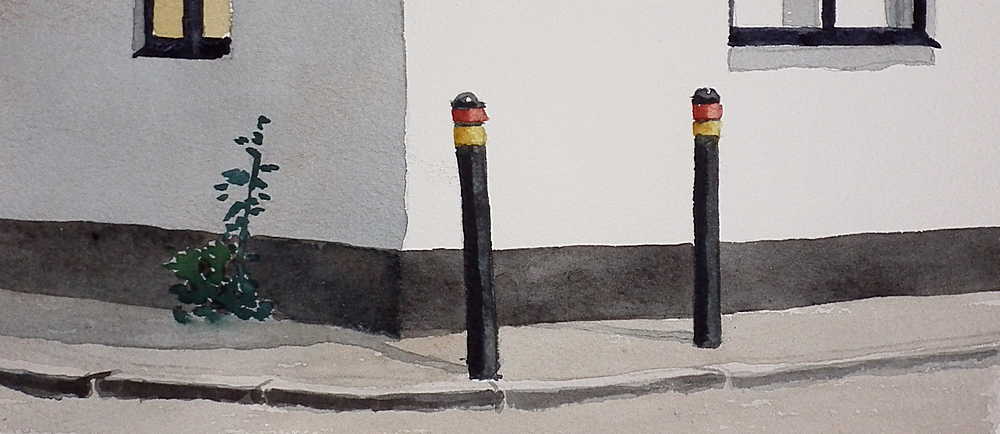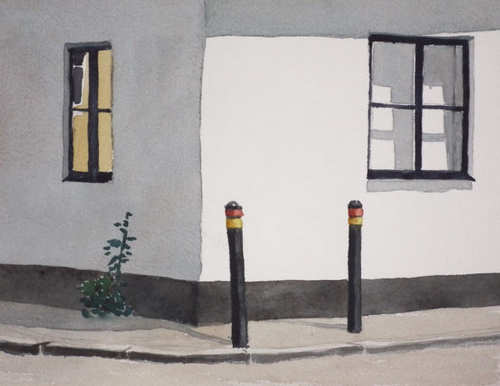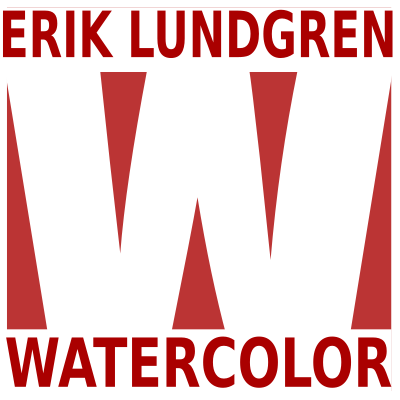Three primary colors | An exercise

This is a fairly simple exercise in terms of painting, but perhaps difficult when it comes to color mixing. The idea of the exercise is to train the ability to paint large surfaces evenly and nicely, as well as to mix with only three colors.
The colors for this painting are three primary colors: Blue. red and yellow. You can choose which ones you want for this. But keep in mind that granulating paints are difficult to get even on larger surfaces. French ultramarine or cobalt blue may not be the best choice.
It works better with phthalo blue, Prussian blue or similar. For the yellow color, any color can be used, the red must be cold, i.e. in the pink direction. Quinacridone rose or alizarin works well.
Start by drawing the motif on a fairly small piece of paper, about 25X20 cm (10X8 inches) is enough. When the drawing is finished, you must mix a gray color that will become all the shadows in the painting. The most common is to paint shadows last, after everything else is painted. But in this painting it is better to fix the shadows first.

Mix a fair amount of gray by using roughly equal parts of the three colors. This is a challenge, why not just use a color like paynes gray or some black. The reason is: because this is an exercise, it should be difficult to achieve the right color, that’s how you learn, by coping with challenges. In addition, the gray color becomes finer when you mix it yourself with colors that are included in the other colors of the painting.
The easiest is to first mix two colors until an intermediate color has been achieved. Blue and red become violet, start with them. Then, little by little, add yellow color until a gray color appears. It probably won’t work right away. If the mixture is greenish, add a LITTLE red and a little more if needed. If it turns brown, blue color is missing. The first time this takes a long time, but as you get more experienced, mixes will work better and better.
Step 1

Paint all the shadows with the same color mixture. Keep in mind that all watercolors lighten as they dry, so make your gray slightly darker than you need. The house gable on the left must be covered with gray paint, also the shadow under the roof on the right side of the house must be painted. Do not paint shadow color on the window panes on the left and save the entire window, panes and frame, on the one on the right.
Also paint the shadow on the ground cast by the posts and on the front of the curbs on the sidewalk. Finally, the shadows are painted on the roller blind in the window on the right. Leave the window frame and panes unpainted.
Step 2

Now you can paint the reflections in the window glass on the left. The color is vaguely yellow, so you have to mix all three primary colors to find the right one. Use mostly yellow color plus just a little blue and a little red. Continue mixing until you are satisfied. There is also a window with a white frame in the reflex. Try to include that too.
Then mix a black-green color to be used for the plant in front of the house on the left side. Start with blue paint along with yellow to create a green, then add red paint until the mixture is dark green. Paint the plant.
The sidewalk and street are brownish gray, if you have gray shadow paint left, use it and just add a little red orange (red+yellow) and you’ll find the right shade. Paint the entire sidewalk and street with this color. Paint straight over the shadows on the curb stones, but save the posts.
Step 3

Now the foundation of the house must be painted. It is black so a black color must be mixed. Do this the same way you previously mixed gray shadow paint but with just a little water.
Mix enough paint that there is a little left over when the foundation of the house is finished painting. Paint the house foundation but save the posts and the previously painted plant.
Step 4

Now only the posts, the window frames and a little on the ground remain. Start with the street. Hopefully you have paint left over from when you painted the sidewalk and street, if so use this or make a new one if it’s gone.
Paint the sidewalk and street, a second time, but save a narrow strip for the curbs, both on their front and top. In this way, they appear three-dimensional. Without this detail, they will be completely flat.
When the paint is completely dry, the posts must be painted. Take the remains of the color you used for the foundation of the house and make it slightly greenish with the help of a little blue+yellow.
Avoid painting on the red and yellow reflexes. Paint these when the dark paint is dry. Depending on which yellow and red you use, you may need to mix a little red into the yellow and vice versa. Finally, paint the window frames with the same green-black color that you used for the posts.











